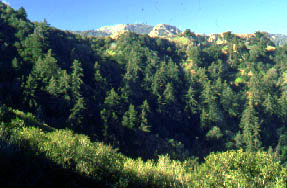
Habitat Linkage
Natural Resources
Trails
Park Features
Directions & Rules
One of
the most distinguishing and memorable characteristics of the
Santa Clarita Woodlands is the presence of bigcone
Douglas-fir trees. Found at a relatively low elevation, this
plant community (classified broadly as part of a mixed
hardwood forest) is more ideally suited to the climatic
regime of 18,000 years ago (wetter, cooler) than that of
today (drier, warmer). This population represents a relic
vegetation type that survives in the higher canyons on
steep, shaded, north-facing slopes. Such vegetation is best
represented in the headwaters of East and Rice Canyons.
Other
elements of this mixed hardwood forest are canyon and coast
live oak, California bay laurel, flowering ash, California
black walnut, and bigleaf maple. Shrubs and herbs commonly
found among these trees are toyon, poison oak, gooseberry,
hollyleaf redberry, mountain mahogany, hairyleaf ceanothus,
Mexican elderberry, creeping snowberry, coastal wood-fern,
goldenrod, heart-leafed penstemon, bush monkey flower,
miner's lettuce, maidenhair fern, elegant Clarkia, and
Chinese houses. An extensive valley oak tree population
occurs along the crest of the Santa Susana range, thriving
on cloud and fog drip and approximately 21.8 inches of rain
per year.
Many
of the forests in the Woodlands have been burned by
wildfires Where severe fire has created openings in the
forest canopy, shrubs, flowering ash and California black
walnut prosper. |
